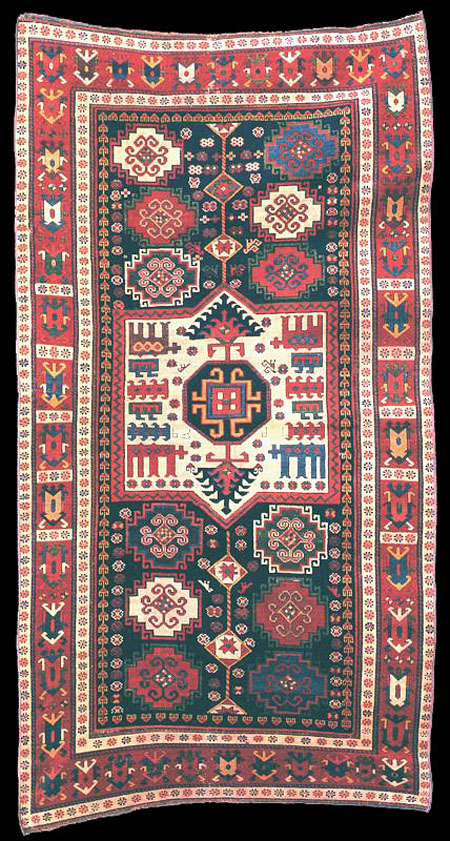|
Rugs of this rare type are sometimes attributed to the Moghan district,
where the use of hooked figures called "Memling guls" was popular. This
piece differs from most other known examples in its border design, a
palmette motif (inverted) that also appears in the Karachov rug (cat.
no.18). The five white bars in the border on either side of the central
medallion are an unusual improvisation. A broad spectrum of particularly
rich colors enhances the visual impact of the rug. Despite an incorrectly
written second digit, the date in the central medallion probably reads 1249
(1833 A.D.). Errors in woven dates serve as reminders that many weavers did
not read or write and therefore did not understand the figures they were
copying.
1. For related examples, see Eberhart Herrmann, Seltene Orientteppiche IV,
Munich, Eberhart Herrmann, 1982, pi. 46, and Raoul Tschebull, Kazak: Carpets
of the Caucasus, New York, Near Eastern Art Research Center, Inc., 1971, pl.
40.
SIZE: 110 x 56 1/2 in. (279.4 x 143.5 cm.)
WARP: wool, Z2S; brown and ivory plied
WEFT: cotton, Z2S x 2; ivory, dyed blue at the ends
PILE: wool, Z2S, symmetrical knots, h. 7, v. 9, 63 k/sq. in.; ivory, dark
brown, red, light red, pink, pink-purple, yellow, light yellow, green,
blue-green,
dark blue, blue, light blue, purple
ENDS: blue wool weft-faced plain weave
SIDES: cut, modern overcast

Sotheby's Auctions » Fine Oriental and European Carpets » lot 47
Sale NY7631
A Kazak rug, Southwest Caucasus,
New York 45,000—55,000 USD Session 1
04 Apr 01 10:15 AM
DESCRIPTION
A Kazak rug, Southwest Caucasus,
second quarter 19th century,
illegibly dated, oxidized browns, remnants of original kilim ends, missing
outer side guard stripes, machine-made overcast sides, minor foldwear with
some repiling, small repaired slit,
approximately 8 ft. 9 in. by 4 ft. 9 in. (2.67 by 1.45m.)
Provenance: Rosalie and Mitchell Rudnick Collection
Exhibited: Through The Collector's Eye, Museum of Art, Rhode Island School
of Design, 1991-2; The Textile Museum, Washington D.C., 1992, no. 20.
Literature: Bailey, J. and Hopkins, M., Through The Collector's Eye:
Oriental Carpets from New England Private Collections, Providence, Rhode
Island, 1991, no. 20, p. 66.
This splendid Kazak belongs to a select sub-group of 19th century rugs
featuring distinctive ivory stepped reserves enclosing charming animals
and birds, supported by two rows of polychrome Memling guls. Other
examples include one previously in the Yohe Collection, see: Sotheby's,
New York, 7 April 1999, lot 143; Herrmann, Eberhart, Seltene
Orientteppiche IV, Munich 1982, p. 152, no. 46; Christie's, London, 29
April 1993, lot 357 and Bennett, Ian, Caucasian Rugs, London, 1981, p. 79,
no. 66.
With the exception of the current lot all related rugs share the same red
ground 'S' gul motif borders whereas this example displays a polychrome
hooked shield palmette border often associated with Karachopt rugs such as
Sotheby's, New York, 27 April 2000, lot 52, also from the Rudnick
Collection and illustrated in Bailey & Hopkins (op. cit.), no. 18.
The inscribed date on the present lot is usually interpreted as reading
1249 A.H. (1833 A.D). See: Hali, Issue 69, pp. 147-8 for a full discussion
of the classification of this rare group of rugs. |

